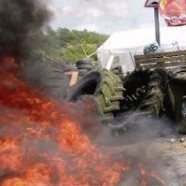More transparency on the offshore and less light
Bonn
Plenary meeting – OSPAR Commission for the protection of the North-East Atlantic
So far from Guyana and yet so close, member states of the OSPAR Commission for the Protection of the North-East Atlantic in Bonn approached the offshore industry with Robin des Bois as their pilot fish. The area of competence of this international Commission extends from the arctic waters to Portugal.
Transparency
About 1,300 oil and gas offshore facilities are established in the OSPAR area, mainly in the North and Norwegian Seas. Pioneering in the field of ocean industrialization, this sector benefits from its geographical isolation. Robin des Bois proposed to the OSPAR member states to accurately map the oil rigs and label each of them with an identity voucher including key dates, water depth, drilling depth in the ocean floor, flags (certain drilling installations in the OSPAR zone are under Panama or Marshall Island flag), names of companies involved (owners, operators, managers, sub contractors…), accidents having occurred on site (fires, oil releases…) and main chronic emissions. This proposition was not greeted favorably by the UK delegation, neither was it by the International Oil and Gas Producers Association (OGP). Enforcing transparency is expensive whereas all the data is available on no free-of-charge databases, they say. These arguments were not convincing. France, Sweden, Spain, and Germany have supported Robin des Bois’s proposal. For once, the NGO will be invited to the next meeting of the offshore Experts Assessment Panel of OSPAR to itemize the project and its implementing means. Until now and for a long time, France had been represented on this panel by TOTAL. Has change finally occurred?
A Full tank of risks in Guyana, Normandy, and in the Arctic
Drilling in Guyana- Press release # 2
Shell is leading the dance in Guyana. The offshore is going to be subjected for over a year to the harmful effects and pollutions of 4 exploratory petroleum drillings and experimental pumping. The Guyanese coast and neighboring countries are not immune to drifts of accidental oil spills. The Scientific Committee of the International Whaling Commission has highlighted the diversity of large and small cetaceans off the coast of Guyana in 2011. Manatees, leatherback sea-turtles, and thousands of migrating birds that come from the Caribbean and Brazil to reproduce on the Grand Connétable Islands are threatened by the ultra-deep drilling thanks to the Shell’s supremacy, pressure from the Guyana elect, and the weaknesses of the French governments. The story began in May 2001, with the issuance from a prefect departmental Prefect order granting an exclusive permit for oil exploration also called the Guyana Maritime license. The energy transition made a detour by the prehistoric era and it is well known that the impact on the environment does not address, far from it, all the risks due to noise, light and atmospheric pollution.











